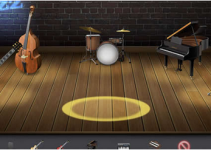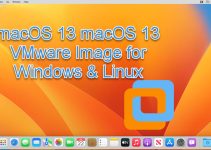Here is a complete and working step by step guide to install Mac OS X 10.7 Lion on VMware with your Windows computer. After several days of research, attempts, and collecting information from different places, I managed to install the Lion OS 10.7 on my Intel computer by using the vanilla kernel.
This method should work on VMware Player also, but I prefer workstation because of the snapshot feature. I don’t think you would face any issues on other types of Intel processors, but make sure that Hardware Virtualization Technology (VT) is enabled. I’m not sure about AMD processors.

This method is completely for testing and learning purpose only.
Requirments
- Latest VMware workstation
- Lion OS X bootable VMDK file created from original installation medium (DVD or ISO file) – Check this guide and make this bootable image as described.
- Additional Files – It is a zipped file with two sets of required files.
One file to patch the VMware software to support Mac OS X guest virtual machines ( Original Source), and the second one with pre-configured Virtual machine files (Original source) and darwin.iso file to install VMware Tools on the guest VM to get more screen resolutions, improved performance and shared folders feature. - Check the hardware VT of your computer BIOS as shown here.
- Just little bit time to read the complete guide 🙂
Steps to Install Mac 10.7 Lion on VMware–Windows 7 Intel PC
1) Download the bootable files.
Download the required files to unlock the VMware workstation.
Before running the patch, I highly recommend taking a full backup of VMware Workstation/VMplayer programs files (Normally located under C:\Program Files\VMware).
When we execute this, it will modify some VMware binary files and unlock VMware application to support macOS guest versions on Windows host.
Close the VMware program completely, then open the command prompt as administrator and execute the windows.bat file (or, even you can right-click on the windows.bat file and run as administrator)
2) Extract the Lion_107.zip file which you download in additional files set. Make sure that the extracted file location is having enough of disk space to grow.
Open Mac OS X Server 10.6 64-bit.vmx file in VMware workstation or VMPlayer.
Go to the settings of the virtual machine and add a hard disk, select the existing option and browse the Lion OS installer image VMDK file we created in the previous guide.
You can modify the memory size and number of processors based on physical computer hardware resources.
Remove the CD/DVD drive file attached with this pre-configured file.
3) That’s it. Start the virtual machine now. It should boot now. It will boot from 5GB vmdk file we created as bootable installer image.
Select the Language on the first screen and start the installation.
4) Select ‘Macintosh’ disk in the next screen. If you can’t see the disk, then go to ‘Utilities’ and click on ‘Disk Utility’. Create a partition as shown below.
5) I’m sure the installation will end smoothly. Complete the initial configurations and setup at the next boot. You can remove the 5GB installer VMDK file from the virtual machine to avoid any overwriting on this virtual hard disk.
6) Here is the working Mac OS X 10.7 Lion on VMware workstation as a virtual machine on Windows OS Intel-based computer. It’s really nice to use and play around with Apple OS on a normal PC.
Take a Snapshot before doing anything now!
Some Post Installation Checkups and Configurations
1) Network
Network inside Lion OS X virtual machine worked out of the box. I tested the NAT and Bridged network types both worked nicely with my physical internet connection.
2) USB storage Access
USB storage access including Flash disk and external hard disk worked fine in VM.
3) Increase Screen Resolution
You will get only one screen resolution size inside Lion OS virtual machine. Install VMware tools to increase the screen size and get more resolution options. VMware shared folders feature will work after the VMware tools installation.
To Install VMware tools, mount the darwin.iso to DVD/CD drive and run the installation then restart the VM.
Here are the available screen resolutions after VMware tools installation.
4) VMware Shared Folders in Lion OS X guest and Windows 10/7 Host
Go to Settings of the virtual machine and select ‘Shared Folders’ under ‘Options’.
Select ‘Always Enabled’ and add the Folder or Partition from Windows host Operating System. That’s it, now try to open the ‘VMware Shared Folders’ shortcut from the desktop of the guest machine.
You should be able to access the host’s shared folder or partition from Lion OS X virtual machine now.
5) Sound
The sound did not work as expected. I hope it will not create any issues in this test environment, who is going to watch move from the VM? It would work properly if you virtualize the macOS on Apple hardware with VMware Fusion or VirtualBox.
6) Update to latest versions
Since we have used the vanilla kernel without customizing any Mac binaries, this version can be upgraded to the latest versions from the Apple app store. If your physical hardware can handle it, you upgrade to the latest version by following the correct upgrade path.
This demonstration was done in the year 2011 on my Intel Core2duo computer. I do not find any valid reasons why you should try this pretty old macOS on the latest hardware when the Big Sur (macOS 11.0) available on the market.













Hands.
I worked out almost the same method.
It works perfectly.
But i forgot to change it to a Server Version. Without this you can’t start it on a Mac in vmWare Fusion.
No, sry. I made the change to Server Version, but it can’t start it in vmWare Fusion, it says no Server Version…
Says operating system not found :/
Sound is working on Lion.
Add Sound card.
Then download audio driver from the link below.
http://sourceforge.net/projects/vmsvga2/files/Audio/EnsoniqAudioPCI_v1.0.3_Common_Installer.pkg/download
I get an error that the pkg requires an os of 10.4 or greater anyone see this error?
Hi you must
1. sudo rm /System/Library/CoreServices/ServerVersion.plist
2. Install the sound driver
3. sudo touch /System/Library/CoreServices/ServerVersion.plist
4. restart
and you had sound card in you virtual machine. I test this on VMWare Fusion 3.1.1
Seems to work just fine. Anybody have a way to add sound
Lionguy,
The earlier reader said its working and point out the driver also.
I have not tried yet, if you can try and let us know.
Yea, sound seems to work fine, thanks to VIJAYADEEBAN
Can you upload this to thepiratebay.org please!!!!
Hi
may you please upload the iso files or the virtual machine you created?
is there any reason i can’t just convert the .dmg to .iso?
Hey I found a torrent for this that is already preinstalled
Here is the link: http://bit.ly/dKyNDX
When Im trying to add a new harddisk it says : “The file specified is not a virtual disk.”
how do i make the full screen desktop bigger and also how do i connect to the internet wirelessly
The CPU has been disabled by the guest operating system. You will need to power off or reset the virtual machine at this point.
i am now getting this message once i ran the script. Can anyone help?
i see per another page this is happening to amd users… can anyone help.???? i have a dual core amd
I’m not sure, but in previous posts, like a post on how to install snow leopard in vmware, it said amd is not supported. My guess is that the same applies for Lion. I might be wrong on this.
Kakeshio: you need to run OS X Unlocker for that error to go away.
hi can someone please tell me how i can get my hard drives to work on mac os x lion on a windows pc vmware also how to get my sound cards to work thanks
hi does anyone know once booted into mac os x on windows pc using vmware on how to install mac os x onto hard drive and how to make the vmware work fast please let me know thank you
Hi at all,
I use VMWare Player and not VMWare Workstation.
Does anybody know if there is a patch for VMWare Player?
The patch in this tutorial does not work.
Thanks in advance
Luca
find “vmware-vmx.exe” in your VMware Player\x64 folder, creat a Path: “C:\Program Files\VMware\VMware Workstation”, put “vmware-vmx.exe” here. run the patch, than put it back.
Hello, a bit off topic but hoping someone knows something about it, im facing a big problem.
I have a old mac but it doesnt boot anymore, tried to fix it with no sucess, i really need to acess a software on it, is it possible to boot that hard drive in Vmware?
thx in advance for any info
You can connect your hard drive to the computer and then in vmware, go add new hard drive. Then select the physical hard drive option. Select your hard drive and it should work.
after i pick my language it says’s “mac os x can’t be installed on this compure” and gives me two options:
“restore from backup” or “restart”. what am i doing wrong? i’m using an Asus laptop with core i7 and windows 7 64-bit.
Yes… I had the same error. Anyone knows why)
You should increase your ram in your virtual machine (Lion need 2 Gb)
My system is the AMD Phenom IIx6, Asus CrossHair 4.
At the apple logo, I have this message:
The CPU has been disabled by the guest operating system…
I think it is because the AMD CPU. Please help.
Straightforward command line work, nicely done.
Now to try and run this on my Apple TV w/ Tiger on it…
Hehehe…
:>)
wen i execte in cmd prompt it show error 5 connt write the data
Hi , i got an error says
” Mac OS X is not supported with software virtualization. To run Mac OS X you need a host on which vMware Workstation supports hardware virtualization ”
Please Help =’)
Your CPU does not support hardware virtualization, meaning that you will not be able to run OS X under vmware.
Or, it means that your CPU does support hardware virtualization, but it is not enabled in the system BIOS, to check this;
When your computer starts up, watch the bios post menu, usually F2, or Delete key will get you into the BIOS, from there you can check the features which are currently enabled for your CPU, and if available enable hardware virtualization.
Steve Jobs, thanks a lot for the valuable information here, you must be busy with Apple company 🙂
You are correct, if hardware VT is not enabled in BIOS, then the above message will appear.
how do you “Add Sound card.” on vmware?
Its easy. Just go to settings of Virtual machine and select Add – then sound card.
Check the comments area for working sound driver for Lion OS X in VMware.
Thanks. New to VMware so I didn’t know but am already learning. I noticed the sound produced is somewhat… laggy (if ever this is the right word). Played a songin iTunes and it sometimes pauses once in a while… anyone else having this problem?
…and yes i know it’s a virtual machine so it is not meant to be perfect, but i just want better performance for all of us guys…
I’ve read you have to create hdd with 20GB+. Normally the file will increase as soon as you working with lion. But you have to create 20gb file first so this will cause less lag. I hope thats the problem.
just to clarify, by create do you mean in step 2 or to add another disk? and will adding another virtual disk solve this problem or will it just waste precious space? also, what will happen after the file exceeds the 40GB maximum size capacity?
and… thanks for the support everyone shows in here. you guys really helped me out a lot.
It needs to be preallocated. So you have to reinstall lion. But this time on a preallocated drive. (this will make a vmdk file with the size you have chosen) Nothing will happen if you exceed 40gb. You can add more. (not on preallocated drives. If you set this to 40gb it will remain as 40gb and you have to add secondary drive then.)
thanks.
I get the error The CPU has been disabled by the guest operating system. You will need to power off or reset the virtual machine at this point.
Please help.
Is your processor supporting Hardware Virtualization Technology (VT)?